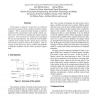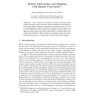CVGIP
2006
14 years 7 months ago
2006
This paper presents a system for rapid editing of highly dynamic motion capture data. At the heart of this system is an optimization algorithm that can transform the captured moti...
GRAPHICSINTERFACE
2000
14 years 8 months ago
2000
This paper describes a technique for using magnetic motion capture data to determine the joint parameters of an articulated hierarchy. This technique makes it possible to determin...
NIPS
2003
14 years 8 months ago
2003
This paper describes a system that can annotate a video sequence with: a description of the appearance of each actor; when the actor is in view; and a representation of the actor�...
GRAPHICSINTERFACE
2007
14 years 8 months ago
2007
Motion capture data is an effective way of synthesizing human motion for many interactive applications, including games and simulations. A compact, easy-to-decode representation i...
APVIS
2010
14 years 8 months ago
2010
This paper proposes a novel visualization approach, which can depict the variations between different human motion data. This is achieved by representing the time dimension of eac...
DAGM
2008
Springer
14 years 8 months ago
2008
Springer
This article presents a genetic learning algorithm to derive discrete patterns that can be used for classification and retrieval of 3D motion capture data. Based on boolean motion ...
HUMO
2000
Springer
14 years 10 months ago
2000
Springer
In this paper we present a system that can synthesise novel motion sequences from a database of motion capture examples. This is achieved through learning a statistical model from...
FGR
2004
IEEE
14 years 10 months ago
2004
IEEE
One of the main difficulties when reconstructing human motion from monocular video is the depth ambiguity. Achieving a reconstruction, given the projection of the joints, can be r...
CAPTECH
1998
Springer
14 years 11 months ago
1998
Springer
bstraction and Mapping with Spatial Constraints ? Rama Bindiganavale and Norman I. Badler Computer and Information Science Department University of Pennsylvania, PA 19104-6389, USA...
SI3D
2009
ACM
14 years 11 months ago
2009
ACM
This paper describes a data-driven approach for generating photorealistic animations of human motion. Each animation sequence follows a user-choreographed path and plays continuou...


